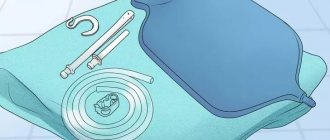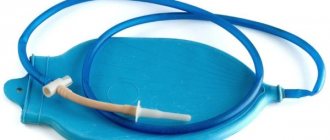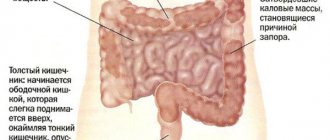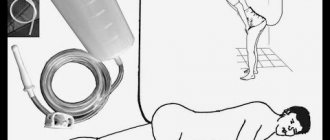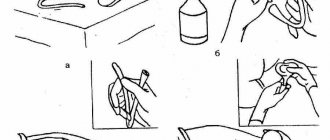Published 01/19/2019 · Comments: · Reading time: 6 min · Views: Post Views: 2,025
Stool retention is an unpleasant condition that everyone has encountered at least once in their life. Most often, constipation occurs against the background of an incorrect diet and lack of nutrition. The best option is to identify and correct the root cause, but this may take some time. An enema to cleanse the intestines at home is a fairly safe, quick and simple method of solving the problem of situational constipation.
What is it and indications for it?
A cleansing enema is a manipulation to cleanse the intestines for various procedures. Involves the introduction of fluid into the colon to quickly remove stool. An Esmarch mug or a syringe bulb is used as a tool. Used in clinics, less often - in outpatient settings.
The main indications for this manipulation:
- poisoning of the body;
- frequent constipation;
- preparation for upcoming surgery on the large or small intestine;
- preparatory procedures before childbirth;
- examination by a proctologist;
- X-ray examination of the pelvic organs;
- upcoming endoscopy or fibrocolonoscopy of the intestine.
Enemas for adults are distinguished by type, depending on the principle of action - cleansing, with medications, siphon for washing, oil-based, subaqueous, hypertonic.
Contraindications to the use of Esmarch's mug
It is unacceptable to give enemas to cleanse the intestines if you have:
- heart failure in severe form;
- bleeding from the gastrointestinal tract;
- acute peritonitis;
- inflammation of the appendix;
- inflammatory and/or ulcerative lesions of the mucous membrane;
- malignant tumors formed in intestinal tissues;
- Crohn's disease.
It is unacceptable to irrigate the vagina:
- for several days (5-7) after surgery or abortion;
- within 25 days after birth;
- during pregnancy;
- during menstruation;
- in the presence of inflammatory processes occurring in the genitourinary organs.
The benefits and harms of enema for colon cleansing
Experts have different assessments of the beneficial and harmful qualities of enemas.
Forced cleansing technology is of significant benefit if a person experiences prolonged constipation or partial bowel movements. Eliminating stool prevents toxins from poisoning the body. The technique is useful for food poisoning, when the poison continues to act in the intestines.
After washing, a person feels much better. The feeling of discomfort and heaviness disappears, intestinal fullness and pressure on internal organs decrease. A clean intestine better absorbs nutrients, which improves metabolism. After the procedure, an adult’s appetite decreases and less food is required to satisfy hunger. Regulation of sleep and normalization of digestion are observed. The immune system is strengthened against the background of normal microflora.
Improper use or abuse of cleansing procedures can cause significant harm to the body. With frequent use of an enema in an adult, there is a risk of microflora disruption. Malabsorption occurs, problems with digestion and defecation occur. An inflammatory process may develop, which will lead to a general deterioration of the condition and problems with bowel movements.
There is a risk that intestinal motility will decrease due to frequent forced cleansing.
Enemas can cause significant harm to the body of an adult if there are contraindications. As a result of such actions, the patient’s condition deteriorates and dangerous complications develop.
Consequences of constipation
Decreased physical activity leads to problems with bowel movements. Constipation may occur after just 2 weeks of bed rest. The problem is especially relevant for the body of an elderly person. The pathology is aggravated by the psycho-emotional state. Ashamed of natural bowel movements, the patient tries to keep feces inside for as long as possible. When they accumulate, they disrupt intestinal tone and provoke intoxication of the body.
Complications of constipation cause the following conditions in bedridden patients:
- disruption of the gastrointestinal tract;
- development of paraproctitis and hemorrhoids;
- intoxication and irritation of the intestinal mucosa;
- spread of infection;
- enteritis;
- oncological neoplasms.
The immune system of a bedridden person is weakened, so you need to know how to give an enema to a bedridden patient and empty the intestines in a timely manner, preventing the development of complications.
https://youtu.be/cK1AXlU0byc
Review of popular colon cleansing solutions
A simple and popular solution is to use regular drinking water. It should be boiled and have a temperature of up to 18–20 degrees. Apply in an amount of about 2 liters.
An oil enema is a type of laxative. Involves the introduction of oil. Used for severe constipation. A solution of such an enema for cleaning the intestines of an adult envelops the fecal stone and facilitates its removal. 100 ml of oil is warmed to room temperature and administered through the anus. To wash, do another enema with chamomile infusion. Can be used for constipation during pregnancy.
Garlic peeling is used to combat parasites (pinworms). According to the recipe, to prepare the solution, chop a head of garlic and add warm boiled water. The solution is infused for 12 hours, after which it is filtered and administered rectally. The quantity of one serving is 80–100 ml. Removal of feces with worms occurs 5–10 minutes after manipulation.
Microlax is a laxative from the pharmacy that is used to ease bowel movements. The drug contains citrate, sodium lauryl sulfoacetate and auxiliary components. Helps liquefy stool. The effect of using a microenema in an adult is achieved 5-20 minutes after administration of the rectal solution. Relevant for use before diagnostic procedures. Used to perform colonoscopy, if necessary, x-rays, ultrasound to make a diagnosis.
Enemas with bifidumbacterin to normalize intestinal microflora. Used for chronic gastrointestinal diseases. To carry out 2-3 doses of the medicine, dilute it in 40 ml of cool boiled water. Administered rectally using a syringe bulb after using a cleansing enema for adults 1 time per day for 10 days.
Barium suspension. It is a contrast agent. Used for irrigoscopy. If intestinal obstruction is suspected, the proctologist can replace the mixture with a water-soluble contrast agent.
Soda solutions are used to normalize acidity. Dissolve 30-40 g of soda per 1 liter of liquid. The best effect is achieved by adding a small amount of salt to the solution.
Herbal enemas have a number of beneficial properties - they nourish, cleanse, normalize pH, stimulate the removal of gases, and eliminate stagnation. For herbal solutions, mint, chamomile, sage, and eucalyptus are used.
Lemon or apple cider vinegar. The use of acid helps cleanse the intestines of parasites, mold, and remove accumulated toxins. It should be borne in mind that with a high concentration of lemon or vinegar, a person will feel severe discomfort.
Ognev's solution is used to stimulate peristalsis. Consists of hydrogen peroxide, salt, soap solution, dry wine. It is one of the most effective cleaning methods, but it produces unpleasant sensations after use.
Glycerin enemas enhance the peristalsis of the adult intestine, due to which the act of defecation occurs. Glycerin coats stool, facilitating its elimination. For douching, use 15-20 ml of glycerin. Glycerin suppositories are used, which have a similar type of action.
The choice of the required solution is carried out according to medical indications, taking into account the existing problem.
Contraindications
Not all categories of bedridden patients can be given an enema. There are cases when this procedure is contraindicated. It is forbidden to forcefully cleanse the intestines under the following conditions:
- open wounds in the abdominal cavity;
- the presence of hernias in the groin;
- the presence of hemorrhoids in the acute stage;
- pregnancy;
- malignant intestinal tumors.
It is not recommended to use cleansing procedures more than 2-3 times a month. It is necessary to eat properly and drink enough fluids. This way you can avoid the accumulation of feces. Knowing how to give an enema to a bedridden patient at home, loved ones can alleviate his condition and improve his quality of life.
Instructions for performing a cleansing enema
The recommended time for the procedure is 6-7 am or 20.00-21.00 pm. In order for use by an adult to be effective and painless, it is necessary to follow the correct algorithm of actions. To introduce an aqueous solution, the following technique is used:
- at the first stage, up to 2 liters of clean liquid at room temperature are prepared;
- if the manipulation is performed at home, you should prepare a tripod on which the container with the solution will be placed;
- set Esmarch's mug on a tripod;
- air and some liquid are released from the hose;
- the person lies on his side, pressing his limbs to his stomach;
- treat the tip with Vaseline or special lubricant;
- the tip of the hose is inserted into the anal passage using rotational movements;
- open the faucet and the hoses so that the liquid begins to flow into the intestines.
After administering the solution, the person needs to lie down for 10-15 minutes. After the expiration date, you can visit the toilet.
This scheme will allow you to cleanse the intestines quickly, effectively and with the least inconvenience for the patient. If the procedure is carried out at home, you cannot do it without outside help. At the hospital, the patient will be taken care of by the medical staff.
Enema technique
If you follow the procedure algorithm, discomfort will be minimized.
- The patient lies on his left side, pulls his legs towards his stomach or leans on his elbows and knees.
- The tip is inserted into the anus, advanced to a depth of 10-15 cm. If you feel that it is stuck, you need to pull the tip in the opposite direction by 2 cm.
- The clamp on the hose is loosened, water begins to flow into the intestines.
- If a person feels a pain in the abdomen or the urge to defecate, one should pinch the hose and take several deep breaths. When the discomfort subsides, the infusion is continued.
- At the end of the infusion, the hose is clamped. The tip is removed from the intestine, pointing its hole down. The plastic element is removed, washed, and boiled.
- After the enema, it is advisable to retain the liquid in the intestines for 5 to 10 minutes. Then you can go to the toilet.
- You need to remember that all the poured liquid may not come out at once, so you should not go far from the toilet.
The algorithm for self-administering an enema is not much different from that described above. Without outside help, it is more convenient to insert the tip and hold it while in the knee-elbow position. It is difficult to regulate the water pressure using a clamp, so the hose is pinched with your hands, bending it.
How to give an enema to a child
The baby lies on his back during the procedure. His legs are raised towards his stomach and slightly to the side. A child older than one year can be on his side with his knees bent.
For the procedure of intestinal lavage in children, a sterilized rubber bulb is used.
- Its soft tip is lubricated with Vaseline or baby cream.
- The syringe is held vertically and squeezed until the water pushes out the air.
- Without unclenching your hands with the bulb, insert the tip into the intestine. Advance 5 cm.
- Gently squeeze the rubber container so that water enters the intestines.
The volume of fluid depends on the age of the child. For an infant you will need 100-300 ml of solution; older children are given up to 700 ml. After 15-20 minutes, the child can be put on the potty.
Constipation is not a reason to give a laxative or do an enema without your doctor's permission. Independent and frequent intestinal lavage can worsen the baby’s condition.
How often can you do an enema and what volume?
Many people, in pursuit of their ideal weight, try to lose weight in every possible way. An enema is often used for this purpose. Doctors warn that carrying out the procedure for the purpose of losing weight is pointless and dangerous. A person can spoil the microflora and disrupt the digestion process.
Experts recommend cleansing the intestines no more than once every 15 days, if indicated. In case of severe constipation, it is allowed to give a repeated cleansing enema to adults.
For intensive cleaning as prescribed by the doctor, a treatment course of 14 days using an enema is possible. An adult changes his diet and refuses fatty foods. Enriches the menu with vegetables and fruits.
The volume of an enema for an adult depends on the purpose of use and the patient’s weight. The optimal volume is 1-2 liters.
To determine the size of the device, you can measure your own waist. If the girth is up to 50 cm, 0.5 l is needed, from 50 to 70 cm - 1 l, from 70 to 85 - 1.5 l, from 85 cm - 2 l of liquid.
Average cost of enemas for home use
You can buy suitable enema supplies at a pharmacy or pharmacy store. When ordering online, a lower price is promised, but you must not forget about paying for delivery. The cost depends on the manufacturer, quality, size. For example, the Esmarch Mug comes in three types:
- No. 1 per 1000 ml - 220 rubles;
- No. 2 for 1500 ml - 255 rubles;
- No. 3 for 2 l - 250 rub.
Tips are sold separately for 15 rubles. You have to buy them more often because boiling destroys the material. The length of the hose must be indicated on the product.
A sterile disposable mug costs 195-220 rubles, with two tips - 350-520 rubles.
The table shows the prices for syringes.
| With soft tip | With hard tip | ||
| Volume in ml | Price in rubles | Volume in ml | Price in rubles |
| 30 and 70 | 110 | 95 | 145 |
| 230 | 210 | 150 | 170 |
| 317 | 275 | 230 | 220 |
| 490 | 320 | 347 | 280 |
| 700 | 350 | 483 | 295 |
You can buy a rubber combined heating pad for 2 liters for 275 rubles, for 3 liters - 295.
How to understand that the intestines have been cleansed
Cleansing can be called successful if a person feels emptiness and lightness in the stomach and intestines.
If, when walking or pressing the abdomen, a person feels bubbling or movement of fluid, incomplete cleansing has occurred. In this case, it is recommended to repeat the procedure. Water should not remain in the intestines, as it will lead to painful discomfort.
People with chronic constipation are recommended to use microenemas with special preparations before cleaning.
Factors that cause constipation
Constipation occurs due to poor intestinal motility, which can be caused by various factors. Physical inactivity, poor microcirculation in tissues and decreased metabolism lead to decreased motility of the gastrointestinal tract (GIT).
Additional causes of constipation:
- intestinal diseases;
- drug intoxication;
- poor nutrition;
- lack of fluid in the body.
Note. Frequent use of laxatives leads to habituation of the intestines and inhibits the natural process of peristalsis.
